Updated on October 24, 2023
Diffuse large B cell lymphoma (DLBCL) is the most common form of non-Hodgkin’s lymphoma. DLBCL begins with mutations to B cells, a type of immune cell that produces antibodies that protect the body from infections, toxins, and parasites.
DLBCL is considered an aggressive cancer. It tends to grow quickly and can spread to other parts of the body. Because DLBCL is an aggressive cancer, treatment usually begins at diagnosis. Delaying treatment can give the cancer more time to grow and spread.
Initial treatment of DLBCL
Treatment for DLBCL typically begins with a combination of different chemotherapy drugs and one or more immunotherapy drugs. Chemotherapy drugs attack quickly multiplying cells within the body. In many cases, this makes chemotherapy effective at destroying cancer cells. Immunotherapy drugs help the body’s immune system identify and attack cancer cells. When used together, this is called chemoimmunotherapy.
Chemoimmunotherapy is sometimes followed by consolidative radiotherapy. Also known as post-remission therapy, consolidative therapy is an additional phase of treatment that aims to eradicate any remaining cancer. External beam radiation is commonly used.
Many people with DLBCL respond well to this approach to treatment. But for many others, the cancer does not respond to initial treatment, or relapses after initial treatment.
Treatment for refractory and relapsed DLBCL
If DLBCL has not responded to treatment or has relapsed, the first thing a person should know is that there are other treatment options available.
There are numerous anti-cancer drugs and regimens that are used as alternative therapies for DLBCL. Alternative therapies are treatments that are used when cancer does not respond to initial treatment. There are also treatments for DLBCL that are approved when two or more therapies have not worked.
Alternate or “salvage” chemotherapy. The term “salvage therapy” refers to using a different regimen of drugs than the initial treatment. Different chemotherapy drugs work in different ways, and different cancers respond to different chemotherapy drugs. A regimen may also include one or more immunotherapy drugs.
CAR T-cell therapy. Chimeric Antigen Receptor T-cell therapy is a type of immunotherapy. It involves collecting and modifying immune cells from the person being treated for DLBCL. The modified immune cells are then given as infusions. This helps the immune system fight the lymphoma. Multiple CAR T-cell therapies are approved for the treatment of DLBCL.
Targeted therapy. Targeted therapies are drugs that target specific proteins or receptors on cancer cells, and prevent cancer cells from growing, multiplying, and/or surviving. A targeted therapy drug may be given on its own or in combination with other cancer treatments.
Bispecific antibodies. These are drugs that include two synthetic antibodies. One binds to cancer cells. The other binds to immune cells called T-cells. The two antibodies act like magnets, drawing cancerous cells to the immune cells, helping the immune system to destroy cancerous cells.
Antibody-drug conjugates. These drugs are a combination of targeted therapy and chemotherapy. Once in the body, the drug will bind to protein receptors on cancerous cells to deliver a dose of chemotherapy. This can target cancerous cells more accurately than standard chemotherapy.
Autologous stem cell transplant. This is only an option for some people with DLBCL. It involves collecting healthy stem cells from the person being treated. Stem cells are stored while a person receives high doses of chemotherapy to eradicate the lymphoma. A person then receives an infusion of their healthy stem cells, which the body can use to create and replace its supply of healthy white blood cells.
Questions when starting a new treatment
Treatment for DLBCL is about finding a treatment approach that the cancer responds to, as well as a treatment that meets the needs of the person being treated. Here are a few questions to ask your healthcare team when starting a new medication:
- What is the therapy that is being recommended?
- Why is this therapy being recommended for my diagnosis?
- How is this therapy different from previous treatments we have tried?
- How does this therapy work to treat DLBCL?
- How is this therapy administered?
- How many doses will I need? What is the dosing schedule?
- What side effects can this therapy cause?
- How will we know if the therapy is working?
- What is the cost of treatment?
- What are the treatment options if this approach does not work?
Should you consider applying to a clinical trial?
Mentioned above, additional therapies for DLBCL are under development. A person with DLBCL may want to consider participating in a clinical trial. This may offer access to different treatment options that are not yet available. It also offers an opportunity to contribute to research and knowledge that can help other people affected by DLBCL.
If the idea of participating in a clinical trial is something that interests you, talk about this with your healthcare providers. As with any aspect of treating DLBCL, your healthcare providers will be your best source of information.




